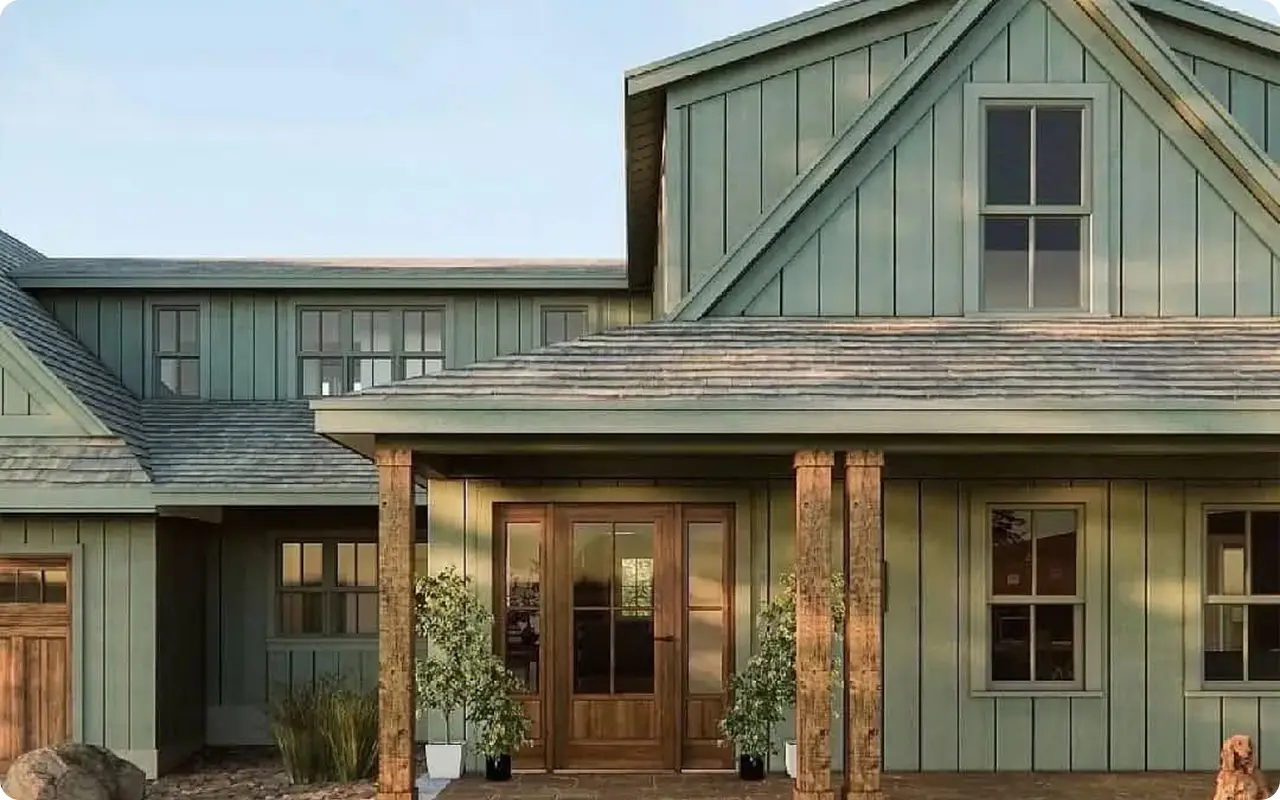I’ve always had a soft spot for green paint—especially in a farmhouse-style home. There’s just something about it that feels peaceful, natural, and effortlessly timeless.
Maybe it’s because it reminds me of old garden sheds, sagebrush on a breezy afternoon, or the faded shutters on my grandparents’ farmhouse.
Green just works in these spaces. It feels grounded. Familiar. Like it’s always belonged there.
When you’re decorating in a farmhouse style, you want colors that feel welcoming and real—and green has that cozy, lived-in charm. But not just any green will do.
The best farmhouse greens are soft, earthy, and a little bit weathered.
Some lean sage, others drift into olive or gray, and a few carry just a hint of blue. Each one tells a slightly different story, and finding the right one can completely change the way a room feels.
In this post, I’m sharing 19 of my favorite farmhouse green paint colors.
These are the greens I keep coming back to—whether I’m working on kitchen cabinets, accent walls, or just looking to bring a little calm into a space.
I’ll walk you through what makes each color special, their undertones, and why they work so well in a farmhouse-style home.
If you’re dreaming of green, I think you’ll find something here that speaks to your style.
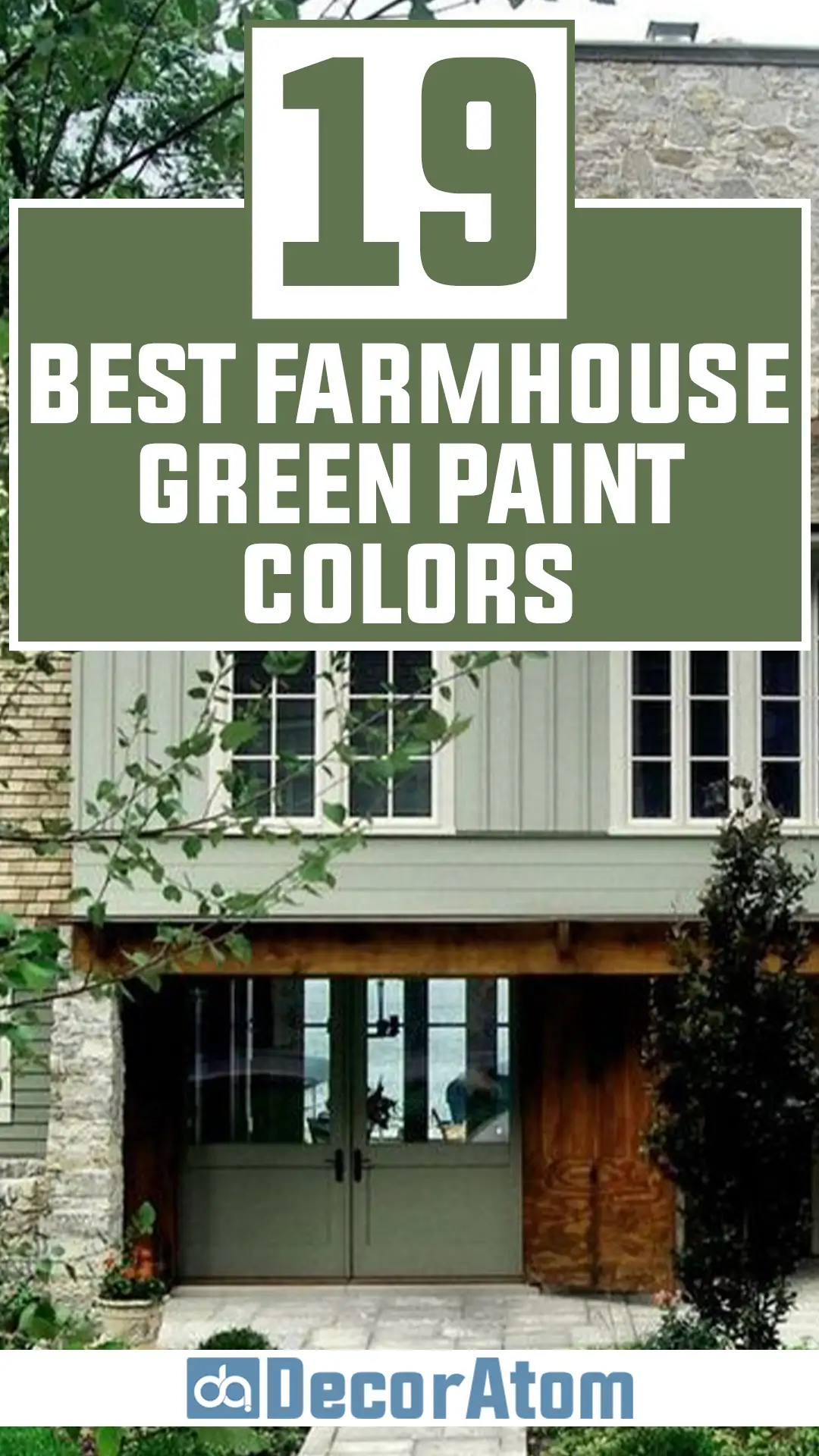
Why Choose Green for a Farmhouse Style Home?
Green is one of those timeless colors that just feels like home—especially in a farmhouse setting. Rooted in nature, green brings a sense of calm, balance, and organic beauty that blends seamlessly with the raw, honest charm of farmhouse design.
It can feel fresh like a spring garden, cozy like a mossy path, or moody like a fog rolling through the countryside. It’s versatile, approachable, and plays well with all the natural textures that define farmhouse style—think reclaimed wood, linen, wicker, and worn metal.
What makes green such a standout in farmhouse spaces is how it softens a room without making it feel overly delicate. Whether it’s a muted sage on kitchen cabinets or a dusty olive on the walls of a living room, green feels grounded and familiar.
It reflects the quiet beauty of rural life—gardens, fields, forest edges—and helps create that lived-in, collected-over-time feeling that farmhouse interiors are known for.
Green also pairs beautifully with farmhouse whites, warm creams, charcoal blacks, and antique wood tones.
So whether you’re going for a modern farmhouse look with sleek black hardware and crisp white trim, or a more vintage vibe with heirloom pieces and warm brass accents, there’s a green that will slip right in and bring everything together.
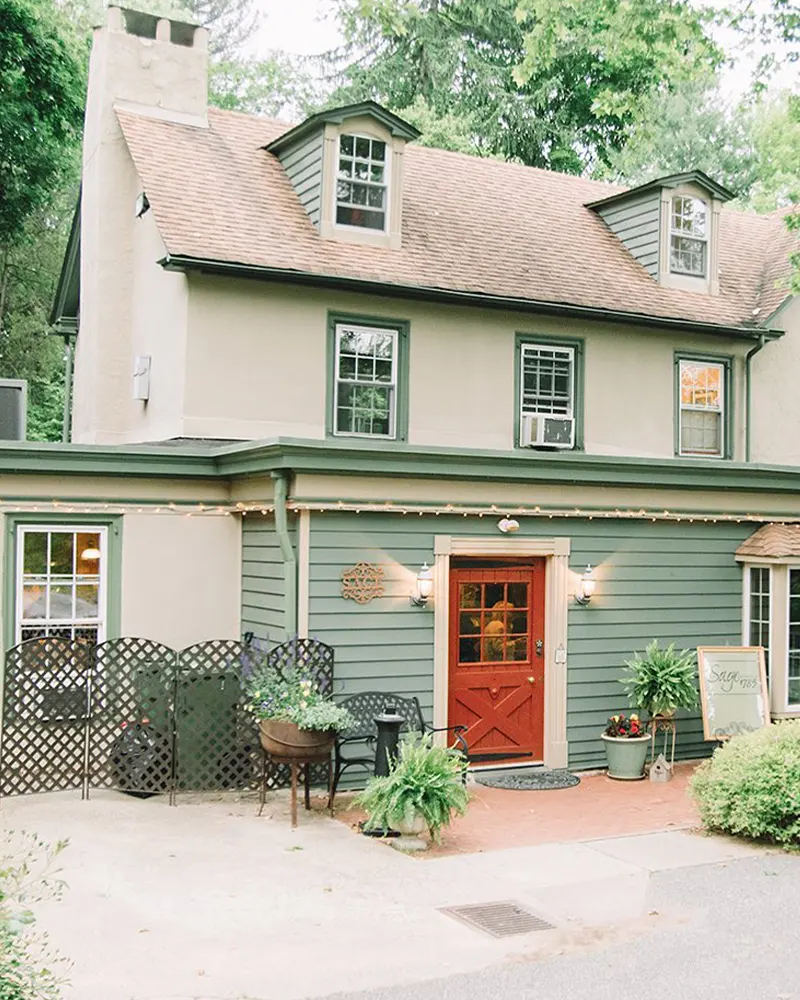
Tips for Choosing the Best Farmhouse Green Paint Colors
Choosing the right green for your farmhouse space comes down to finding a shade that feels relaxed and rooted. Farmhouse greens tend to lean toward muted, dusty, or nature-inspired tones—nothing too bold or neon. Here are a few tips to help you land on the perfect shade:
1. Pay Attention to Undertones
Farmhouse greens often carry gray, brown, or yellow undertones that give them a more earthy, timeworn look. For example, sage greens have a hint of gray that keeps them soft and subtle, while olive greens pull in warmth and create a cozy, heritage feel. Cooler green-grays can add a slightly moodier edge, perfect for more refined or modern farmhouse palettes.
2. Test in Natural Light
Lighting changes everything—especially with greens. A color that looks soft and inviting in the morning sun might turn cooler and moodier in the evening. Be sure to sample your top picks on different walls and observe them at different times of day before committing.
3. Consider Where It’s Going
Think about how the green will function in the space. A soft green like sage or sea glass works beautifully in kitchens, bathrooms, and bedrooms, where you want a sense of freshness and calm. Deeper greens like olive or forest tones bring richness to accent walls, cabinetry, and living spaces where you want a bit more contrast and depth.
4. Balance with Neutrals and Texture
Farmhouse style is all about layering texture and warmth. Greens really shine when paired with natural woods, off-whites, aged metals, and cozy textiles. Keep your green color grounded by surrounding it with classic farmhouse neutrals and plenty of texture.
5. Think About the Feeling You Want
Lighter greens like Soft Fern or Contented create a breezy, peaceful feeling, while deeper greens like Green Smoke or Olive Grove bring drama and coziness. Decide what kind of mood you want your space to have, and let that guide your choice.
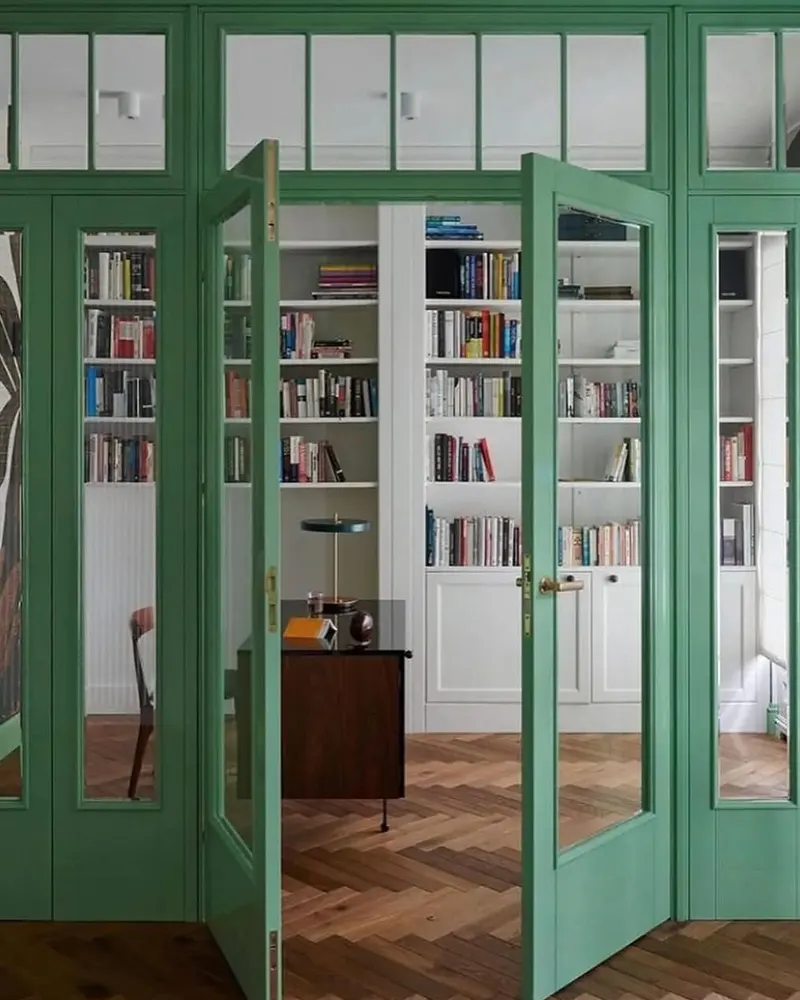
The Best Farmhouse Green Paint Colors
Here are my favorite Farmhouse Green Paint Colors. Each one has its own story to tell, and all of them fit effortlessly into a farmhouse setting—whether you’re leaning modern, traditional, or somewhere in between.
1. Sherwin Williams Svelte Sage

Svelte Sage is one of those quietly beautiful greens that doesn’t try too hard, but always makes an impression. It has a soft, earthy olive base with just enough warmth to keep it cozy without feeling heavy.
The undertones lean into the taupe-beige family, giving it a slightly aged, lived-in character that feels right at home in a farmhouse.
I love it for spaces where you want green, but not the obvious, leafy kind—think kitchen cabinets, a moody hallway, or even a powder room that could use a bit of character.
It pairs beautifully with creamy whites, deep charcoals, and raw wood, and it looks especially charming next to vintage brass fixtures. It’s grounded and unpretentious—exactly what farmhouse style is all about.
2. Benjamin Moore Soft Fern

Soft Fern has a gentle, almost breezy vibe to it that makes it one of my favorite greens for creating a relaxed farmhouse look.
It’s a pale green with slightly yellow undertones, and while it still leans cool, that soft yellow warmth helps it feel welcoming and open.
It almost whispers its presence, which makes it such a good fit for bedrooms, bathrooms, or even an entryway where you want a subtle touch of color that still feels grounded.
What makes Soft Fern stand out is how it reflects natural light—it glows without being too bright. Pair it with crisp white trim or warm antique wood, and you’ve got a space that feels both fresh and timeless.
3. Behr Back to Nature

Back to Nature is one of those greens that lives up to its name—it truly feels like a walk through a spring meadow. It’s a soft, yellow-green with a very natural, botanical vibe.
This color has a lot of warmth, and while it definitely reads green, it also flirts with a creamy softness that makes it perfect for farmhouse interiors that lean on the lighter, more organic side.
I love this shade for kitchens, sunrooms, or spaces that open up to the outdoors. It’s optimistic without being too sweet, and it plays well with natural wood, soft white walls, and woven textures like jute or rattan.
If your farmhouse style includes garden views or lots of natural light, this color will echo those outdoor tones beautifully.
4. Farrow & Ball Green Smoke

Green Smoke is rich, moody, and full of character. This isn’t your subtle, barely-there green—it’s bold in the best way, with a mix of blue and gray undertones that give it depth and a hint of mystery.
It’s got that historic, heritage quality that works so well in farmhouse homes, especially if you’re leaning into the vintage side of the style. I think it’s stunning on lower kitchen cabinets, mudroom built-ins, or even a cozy study or den.
The smokiness in this color makes it incredibly sophisticated, but it never feels cold. It tells a story—it feels like something passed down, like it’s always been part of the house.
For farmhouse lovers who appreciate a little drama without going too dark, Green Smoke is a perfect choice.
5. Sherwin Williams Sea Salt

Sea Salt is one of those magical chameleon colors—it shifts beautifully depending on the light, bouncing between soft green, gray, and even a whisper of blue.
In a farmhouse space, it brings in a coastal breeze without ever going full beach house. It’s incredibly calming and works just as well in a bathroom as it does in a serene, open-concept living room.
Sea Salt has a gentle coolness that keeps it fresh, but it also has enough warmth in its undertones to make it feel cozy. It pairs effortlessly with farmhouse whites, light wood floors, and soft woven textures.
If you’re going for a clean and airy farmhouse vibe with just a touch of color, Sea Salt checks all the boxes.
6. Benjamin Moore Guilford Green
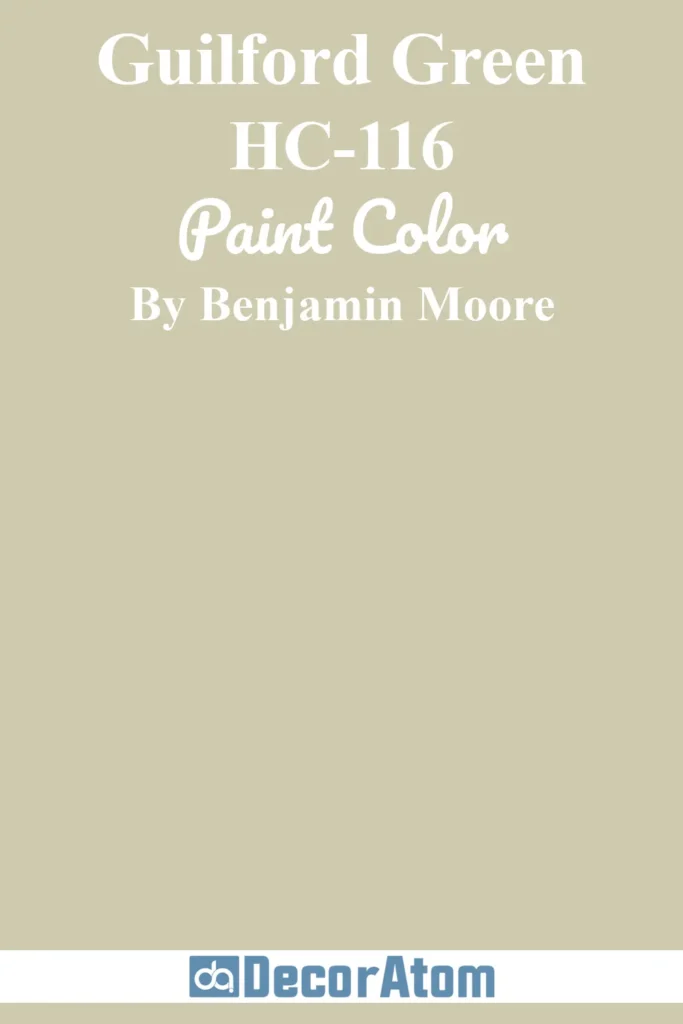
Guilford Green is elegant, mellow, and beautifully balanced. It’s a pale green with a hint of warmth and just enough gray to tone it down.
What I love most about Guilford Green is how refined it feels—like an old farmhouse that’s been lovingly cared for over generations. It doesn’t shout for attention, but it makes a space feel thoughtful and peaceful.
It looks fantastic in a dining room with crown molding, a hallway with antique picture frames, or a bedroom where you want a little color without going bold.
Its soft, slightly sage-y undertones make it incredibly versatile and easy to live with.
7. Sherwin Williams Evergreen Fog

Evergreen Fog was named Color of the Year for a reason—it’s a serene, modern take on farmhouse green that brings together soft green, gray, and a whisper of taupe.
It feels like a misty morning in the countryside. There’s a quiet elegance to it that makes it perfect for large spaces or entire walls, especially in modern farmhouse homes that lean into minimalism with warmth.
It’s neither too warm nor too cool—it hits that rare sweet spot in the middle. This color shines next to soft whites, aged metals, or rustic wood beams.
It’s a lovely choice if you want something a little more atmospheric, but still timeless and cozy.
8. Benjamin Moore High Park

High Park is a deep, earthy green that’s rich without being overpowering. There’s something very grounding about this shade—it feels like forest moss or the leaves of a well-loved houseplant.
The undertones are balanced, but there’s a subtle hint of gray that keeps it from feeling too bright or grassy. I love High Park for feature walls, built-in bookshelves, or even cabinetry in a farmhouse kitchen.
It brings warmth, depth, and that connection to nature that farmhouse homes thrive on. Pair it with natural wood, brushed brass, or matte black, and it really comes alive.
9. Sherwin Williams Clary Sage

Clary Sage is a mellow, botanical green that always feels fresh but never too loud. It has soft yellow undertones that keep it warm, which is exactly why it works so beautifully in farmhouse settings.
It almost has a sunlit quality—like herbs drying on a windowsill. This is the kind of green that works just as well on a bathroom vanity as it does on a laundry room wall or bedroom shiplap.
It brings a sense of life and freshness to a room without taking over, and it looks especially pretty alongside natural textures like rattan, whitewashed brick, or vintage quilts.
If you’re looking for a true farmhouse green with a gentle spirit, Clary Sage is a strong contender.
10. Benjamin Moore Rainy Afternoon
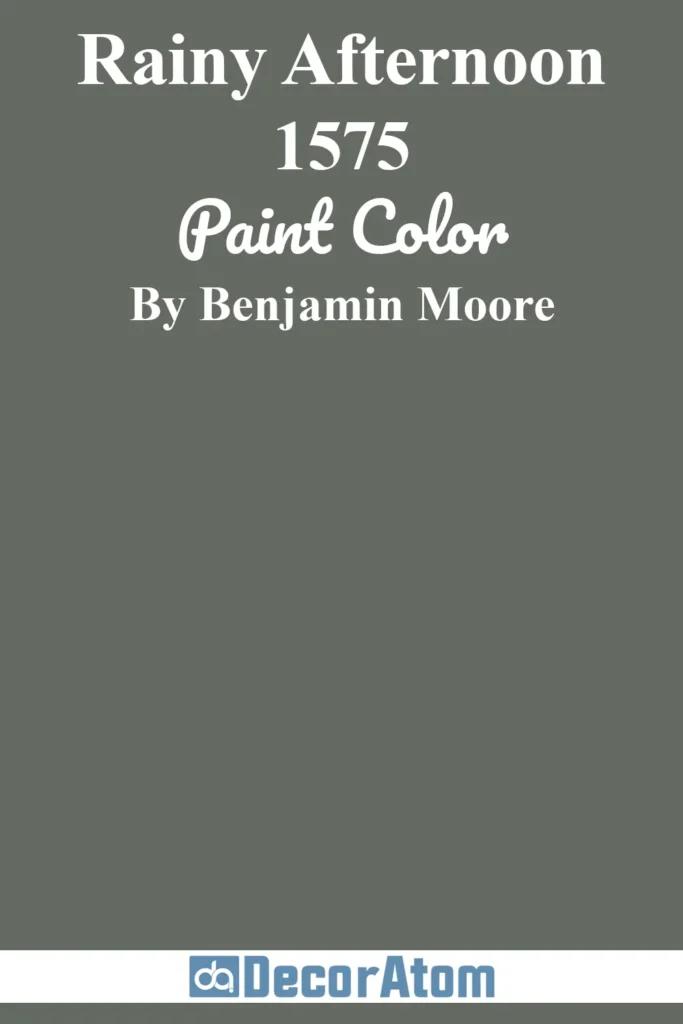
Rainy Afternoon has a moody, stormy charm that sets it apart from other greens on this list. It leans deeper and more dramatic, with strong gray undertones and a touch of blue that gives it a brooding, weathered quality.
This is the kind of green you might use in a cozy library, a farmhouse dining room with candlelight, or a reading nook tucked under the stairs.
It’s elegant, classic, and full of depth. If you’re drawn to darker, more contemplative greens, Rainy Afternoon has that old-soul vibe that pairs beautifully with rustic beams, aged leather, and linen curtains.
It’s a bold choice, but one that brings so much character and richness to a farmhouse space.
11. Benjamin Moore Dakota Woods Green

Dakota Woods Green is the kind of earthy, rugged green that instantly makes a space feel connected to the land.
It’s a mid-to-deep tone, somewhere between olive and moss, with warm brown undertones that give it a grounded, organic feel. I think of it as a “working farmhouse” color—it’s practical, natural, and quietly strong.
There’s no sharpness to it, no artificial brightness. Instead, it feels like something you’d see on the outside of an old barn or painted on weathered shutters.
It’s beautiful on cabinetry, accent walls, or even front doors. If you want a green that brings a sense of history and roots to your space, Dakota Woods Green really delivers.
12. Sherwin Williams Herbal Wash
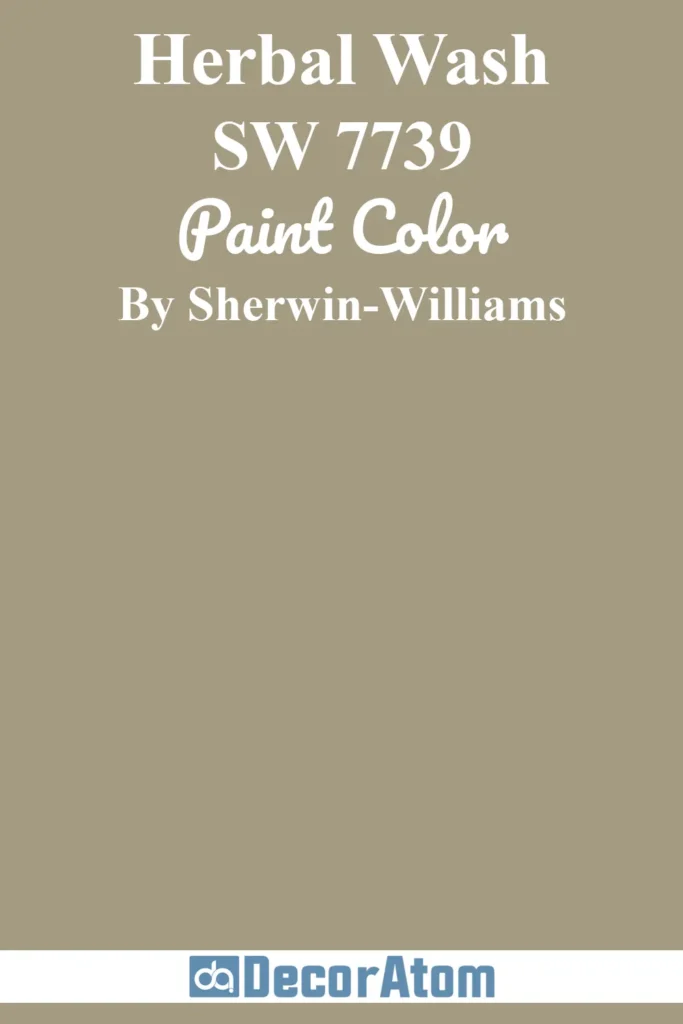
Herbal Wash is one of those newer shades that feels like an instant classic. It has a muted, sage-meets-olive feel to it with soft yellow undertones, and it leans warm without becoming too golden.
It has that sun-washed, slightly faded quality—like a painted wall that’s been touched by years of morning light.
I really love this one in places like kitchens or dining rooms where you want to bring in natural color but keep the atmosphere light and breezy.
It works especially well with farmhouse-style textiles, like ticking stripes, cotton slipcovers, and even wrought-iron hardware. Herbal Wash brings that familiar comfort that farmhouse homes thrive on.
13. Benjamin Moore Lush
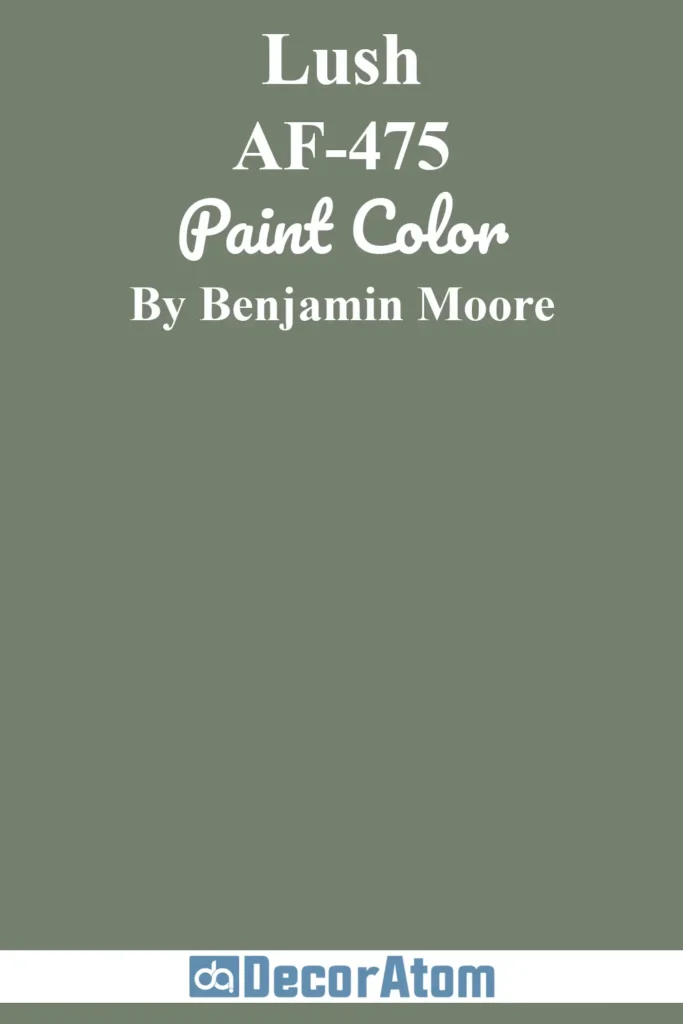
If you’re looking for a green that feels fresh and lively, but still works in a rustic farmhouse setting, Lush is a fantastic choice.
It’s a mid-toned green with definite yellow undertones, but unlike more muted sages, Lush feels a little more vibrant—almost like new spring growth. That said, it doesn’t cross into neon or overly saturated territory.
There’s enough softness and depth here to keep it sophisticated. I can see it working wonderfully on lower kitchen cabinets, mudrooms, or even as an accent wall behind a vintage headboard.
What makes Lush special is its energy—it gives a space life, while still feeling grounded in nature.
14. Sherwin Williams Olive Grove
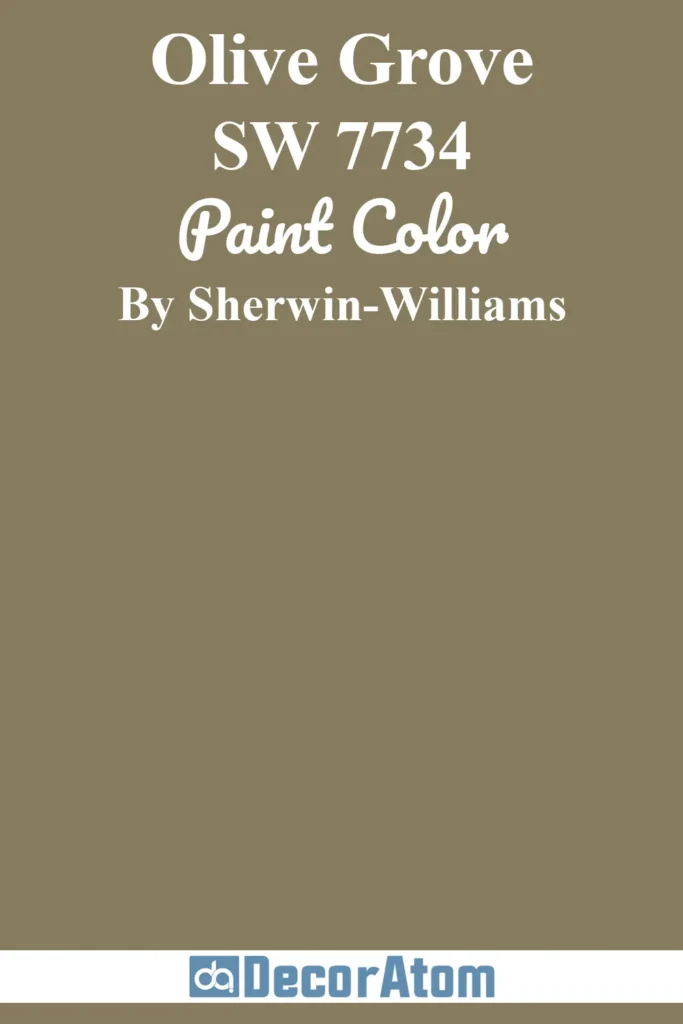
Olive Grove is deep, warm, and full of personality. As its name suggests, it channels those rich, Mediterranean olive tones—dark green with strong golden undertones that keep it from ever feeling too cool.
It’s bold, but in a grounded, rustic way. This color makes a dramatic statement on cabinets, built-ins, or even a moody farmhouse dining room.
It pairs beautifully with aged wood, brass, and creamy whites. Olive Grove feels like something you’d see in a French country farmhouse—elegant, but never flashy.
It brings depth, warmth, and that delicious old-world vibe that’s so hard to find in more modern greens.
15. Benjamin Moore Ashwood

Ashwood is a soft, silvery green that almost reads as a warm neutral depending on the lighting. It has undertones of beige and gray, which gives it a subtle, misty quality.
This color is for the farmhouse lover who wants green but doesn’t want anything too obvious. Ashwood is subtle. It’s calming.
It’s what I’d call a “barely-there” green—perfect for bedrooms, hallways, or even full open-concept spaces where you want a hint of warmth and softness without bold color.
It works beautifully with classic farmhouse whites, soft taupes, and antique linens. It’s not a showstopper in the traditional sense—but it’s a quiet beauty that grows on you with time.
16. Behr Sage Brush

Sage Brush is another wonderfully soft and muted green that just feels like home. It has that classic sage hue—green with a touch of gray and a kiss of warmth.
It’s the kind of color that feels grounded and familiar, like a well-worn wool sweater or the pages of an old book. Sage Brush fits effortlessly into a farmhouse color palette, especially if you’re drawn to vintage, weathered textures.
I love it for kitchens, bathrooms, or even on trim and doors. It has just enough color to bring warmth and interest to a space without overwhelming it.
And the name? Perfectly on brand for farmhouse style—it’s like a nod to nature with every brushstroke.
17. Farrow & Ball Pigeon

Pigeon is one of those moody, atmospheric greens that looks different in every room—and that’s exactly what makes it so magical.
It’s a complex mix of gray, green, and a whisper of blue. In some lights, it leans more slate; in others, you get a deeper, earthy green.
It’s refined and a bit mysterious—perfect for farmhouse spaces with character, like old libraries, pantries, or master bedrooms with lots of natural texture. Pigeon feels elevated, but never stuffy.
It pairs incredibly well with chalky whites, unlacquered brass, and aged wood. If your version of farmhouse style includes European touches or leans into a slightly moodier palette, Pigeon is a stunning, nuanced option.
18. Sherwin Williams Contented
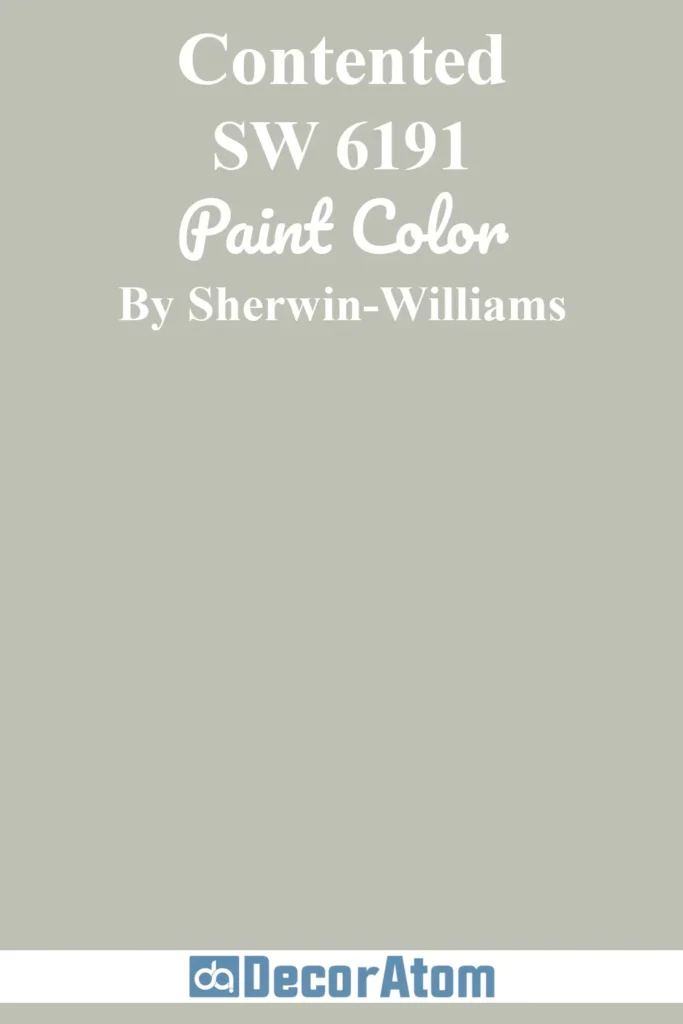
Contented is that soft, peaceful green that almost instantly relaxes the energy in a room. It’s a light-to-mid green with cool undertones and a touch of gray to tone it down.
The name really says it all—it’s not trying too hard; it just creates a gentle, comfortable mood. I love using Contented in spaces where calm is the goal—bedrooms, reading nooks, or quiet living rooms.
It works beautifully with other muted shades, especially soft whites, pale wood tones, and cool neutrals like grays or taupes. If you want green in your farmhouse but don’t want anything bold or dramatic, Contented is a perfect choice.
19. Benjamin Moore Nantucket Gray

Nantucket Gray is an old-soul kind of green. It’s got a warm, taupe-gray undertone that gives it an aged, timeworn appearance.
While the name includes “gray,” it definitely reads as a soft olive green in most lighting. It’s refined, subtle, and full of character.
I love this color in formal dining rooms, traditional farmhouse entryways, or even painted on old doors or trim. It pairs well with classic elements—think crown molding, linen curtains, and antique finishes.
There’s a depth to Nantucket Gray that makes it feel historic without being too heavy. If you want a green with quiet sophistication and plenty of warmth, this one delivers.

